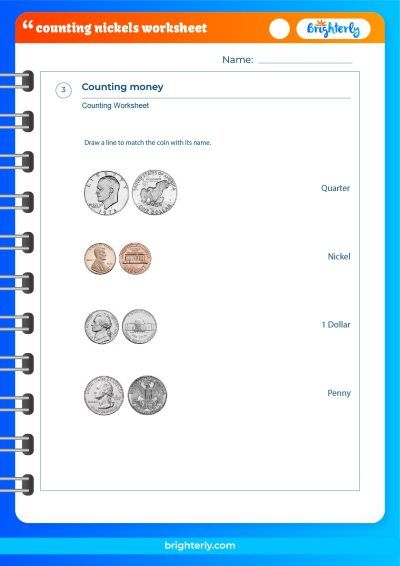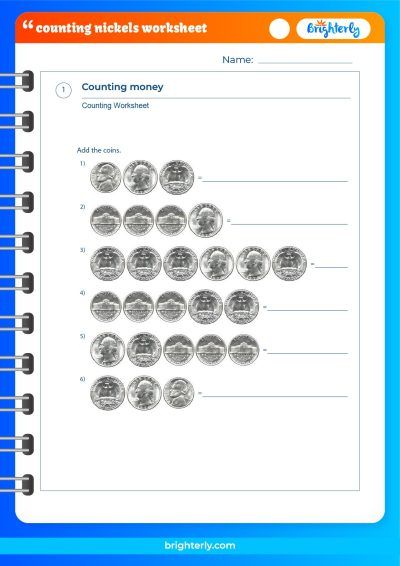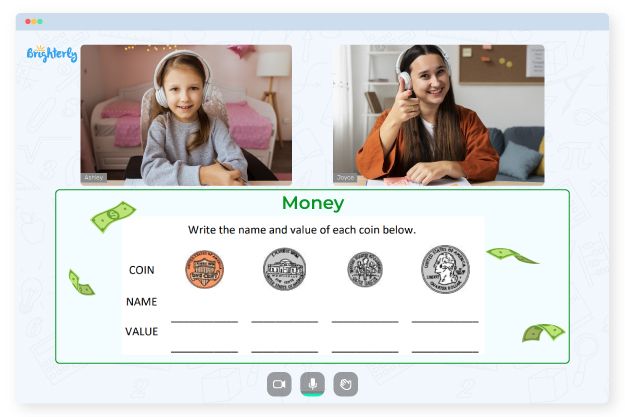What is Nickel? Definition With Examples
Updated on January 12, 2024
Welcome to the exciting world of Nickel! At Brighterly, we believe that understanding the concept of nickel, a fundamental unit of our monetary system, can be a fascinating journey into mathematics and financial literacy. As children, our first introduction to financial transactions often comes in the form of coins. We save them in our piggy banks, use them at the candy store, and sometimes, if we’re lucky, find them on the street.
In the United States, the term “nickel” is used to refer to a coin that is worth five cents. Interestingly, this coin gets its name from the fact that it was originally composed of 25% nickel and 75% copper. However, the concept of nickel money transcends beyond its metallic composition. It represents an important cornerstone in our understanding of the financial world.
But why stop at just understanding what a nickel is? Let’s dive deeper and explore how this small coin fits into the larger monetary landscape. As we journey through this article, you will discover how nickels can be converted into other units like dollars, dimes, and quarters. We’ll also provide you with some examples and practice problems to bring these concepts to life. By the end of this Brighterly journey, you’ll not only be a nickel expert but also a math and finance whiz!
The Concept of Nickel Money
Nickel is a term that we often hear in the context of coins and money. In the United States, a nickel refers to a coin worth five cents. It’s called a “nickel” because it was originally made of a metal composition that was 25% nickel and 75% copper. This fascinating currency unit is not just a piece of money, but a gateway to understanding the larger world of mathematics and finance.
It’s interesting to note how the nickel has been used throughout history. The U.S. Mint began producing these coins in 1866, and it was named for its primary component to distinguish it from other coins. Today, nickels still play a significant role in our economy and are frequently used in transactions.
What Is a Nickel?
A nickel is a coin in the United States currency system that is worth 5 cents. It’s smaller than a quarter but larger than a dime. One side of the coin features the profile of President Thomas Jefferson, while the other side showcases Monticello, Jefferson’s plantation home.
The concept of a nickel is more than just a coin. It’s a fundamental piece of our monetary system, a building block that helps us understand the concept of money and the importance of saving. It’s a tool that can help children learn the basics of financial literacy.
Conversion of Nickels into Dollars
Understanding the conversion of nickels into dollars is a key step in learning about money. Since a dollar is equal to 100 cents, and a nickel is worth 5 cents, it takes 20 nickels to make a dollar. This conversion is a great way to introduce the concept of division and multiplication to children.
Teaching children to convert nickels into dollars also helps them understand the value of money. It’s a practical math lesson that can be applied in real-world situations, such as understanding how much a toy costs or figuring out how many nickels they need to save up to buy a treat.
Conversion of Nickels into Dimes
Just as nickels can be converted into dollars, they can also be converted into dimes. A dime is worth 10 cents, which is twice the value of a nickel. Therefore, it takes two nickels to make one dime.
Converting nickels into dimes is a good way to introduce children to the concept of fractions and ratios. It’s another practical math lesson that children can apply in their daily lives, whether they’re buying candy at the store or saving up for a larger purchase.
You can find the answers and more practice questions in our Nickel Conversion Worksheets.
For more in-depth understanding and practice, don’t forget to check out our comprehensive “Nickel to Dollar Practice Worksheet” available on the Brighterly website. This resource is full of exciting and challenging problems that will help solidify your understanding of converting nickels into dollars, dimes, and quarters.
Conversion of Nickels into Quarters
Finally, let’s consider the conversion of nickels into quarters. A quarter is worth 25 cents, which is five times the value of a nickel. Thus, it takes five nickels to equal one quarter.
Understanding the conversion of nickels into quarters is another valuable lesson in financial literacy. It allows children to compare the value of different coins and understand their relative worth. It also provides another opportunity to practice multiplication and division skills.
Solved Examples on Nickel
To help solidify these concepts, let’s consider a few solved examples. Suppose a child has 15 nickels. By understanding that each nickel is worth 5 cents, they can calculate that they have 75 cents. If they wanted to convert that to dimes, they would divide by 10 and find that they have 7 dimes and 5 cents leftover. If they wanted to convert it to quarters, they would divide by 25 and find that they have 3 quarters.
Practice Problems on Nickel
Let’s put these concepts into practice with some problems involving nickels.
- If you have 30 nickels, how many dollars do you have?
- If you have 10 nickels, how many dimes can you get in exchange?
- If you have 50 nickels, how many quarters can you get in exchange?
These practice problems can help children apply their understanding of nickels, dimes, quarters, and dollars. They can also help improve their math skills by performing calculations with real-world implications.
Frequently Asked Questions on Nickel
Why is a nickel called a nickel?
The coin we call a “nickel” gets its name from the metal it was originally made from. The first nickels were made from a composition of 25% nickel metal and 75% copper. This combination of metals gave the coin its distinct silver color and sturdy structure. The choice to name it after the nickel content was done to distinguish it from other coins.
How many nickels make a dollar?
A nickel is worth 5 cents. Given that a dollar is equivalent to 100 cents, it would take 20 nickels to make a dollar. This calculation is derived by dividing the total number of cents in a dollar (100) by the value of a nickel (5). So, if you’re ever trying to count up to a dollar using nickels, you would need to count to 20. This fact is also a fun way to introduce basic division concepts.
How many nickels make a dime?
A dime is a coin that’s worth 10 cents. This is twice as much as a nickel, which is worth 5 cents. Therefore, it would take two nickels to make a dime. Understanding this can be a great way to introduce the concept of multiplication or fractions to children, as one dime can also be seen as 2/2 or 100% of two nickels.
How many nickels make a quarter?
A quarter is worth 25 cents, and a nickel is worth 5 cents. Therefore, it would take five nickels to make a quarter. This concept can be a great way to teach children multiplication or division. A quarter is five times the value of a nickel, or said another way, a nickel is one-fifth (or 20%) the value of a quarter.
Can you exchange nickels for dollars, dimes, and quarters?
Yes, you can absolutely exchange nickels for dollars, dimes, and quarters. This is usually done at a bank or with a coin-counting machine, which are often found at supermarkets. Exchanging coins can be an excellent way to teach children about the different values of coins, and about how many of each type of coin add up to a dollar. It’s also a practical skill that can be applied in real-world situations, such as calculating the total amount of money in a piggy bank or understanding how much money you have if you find a handful of coins.
Information Sources
Information for this article was gathered from reputable sources including:
These sources provide accurate and reliable information about nickels and their role in the U.S. monetary system.






